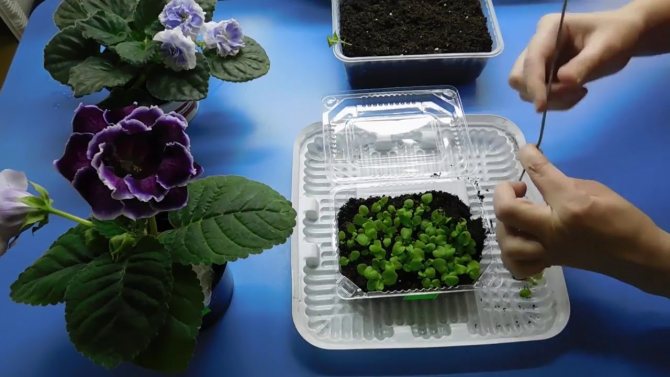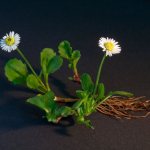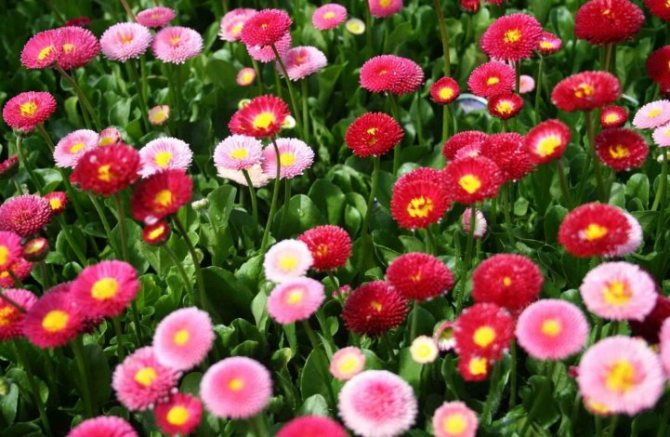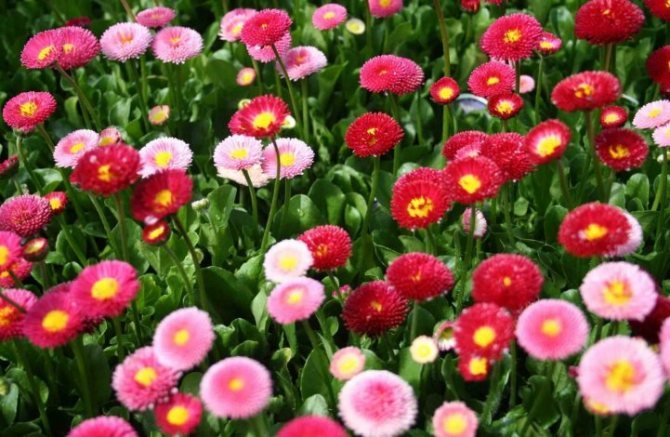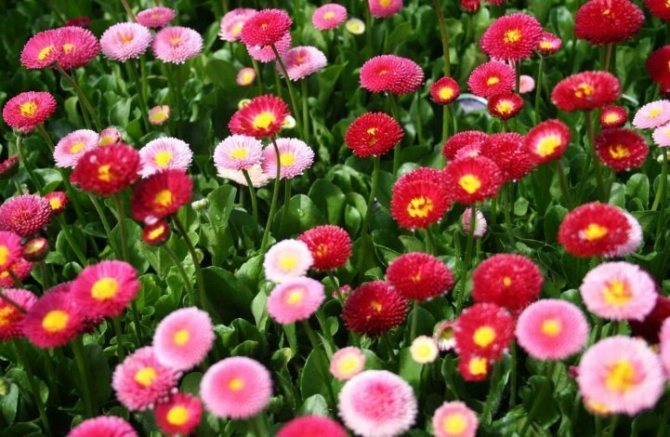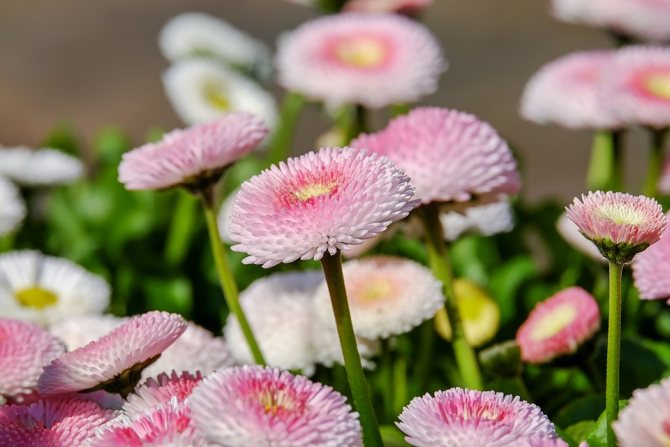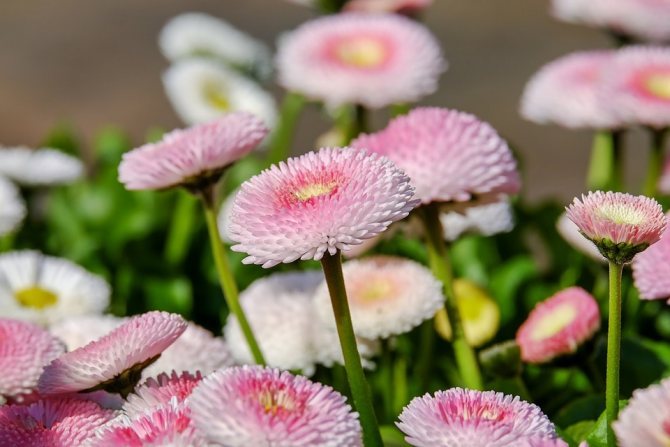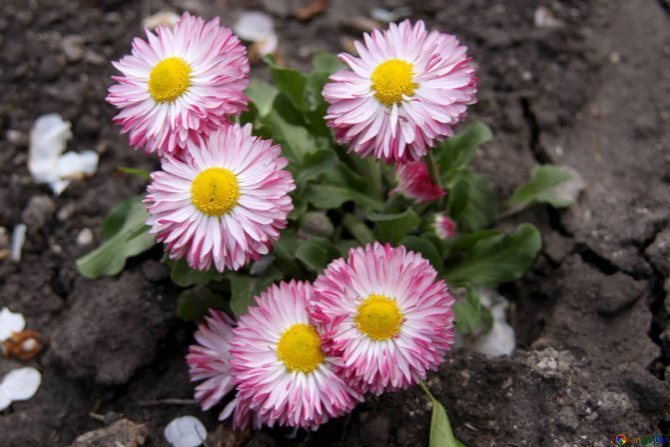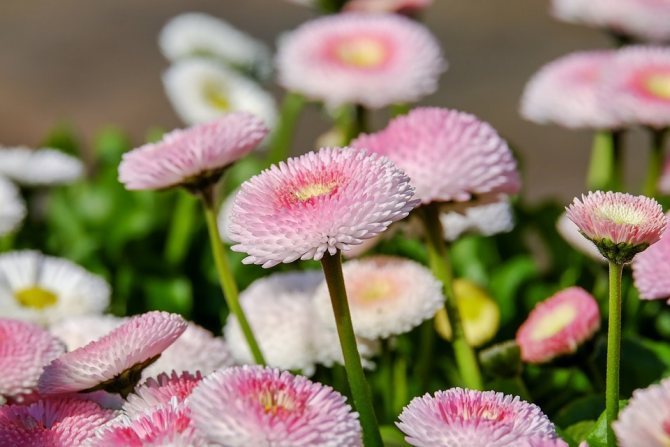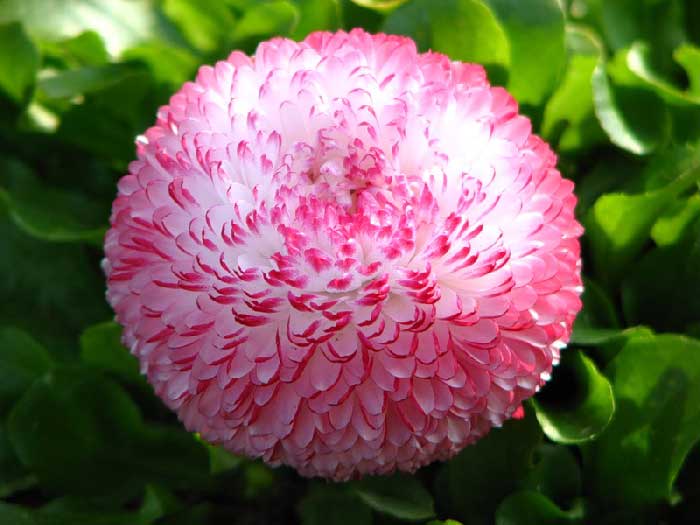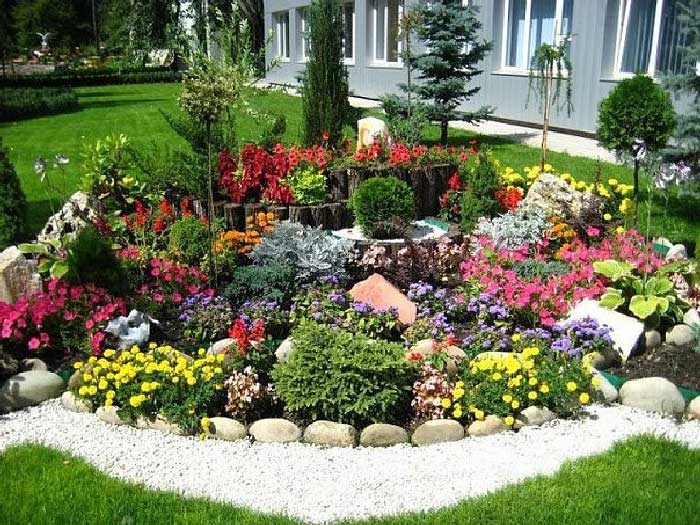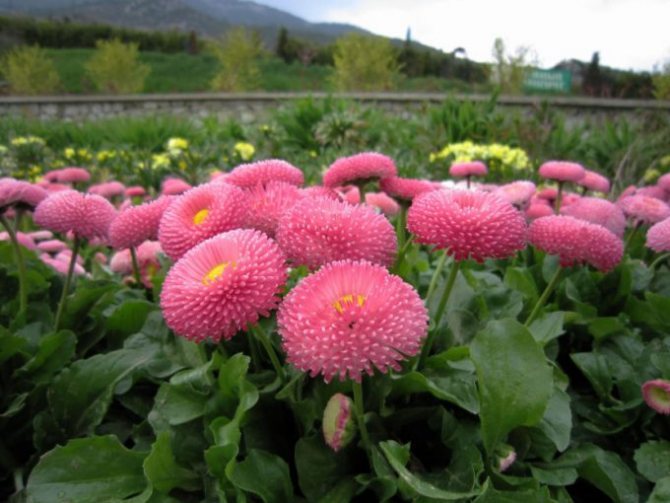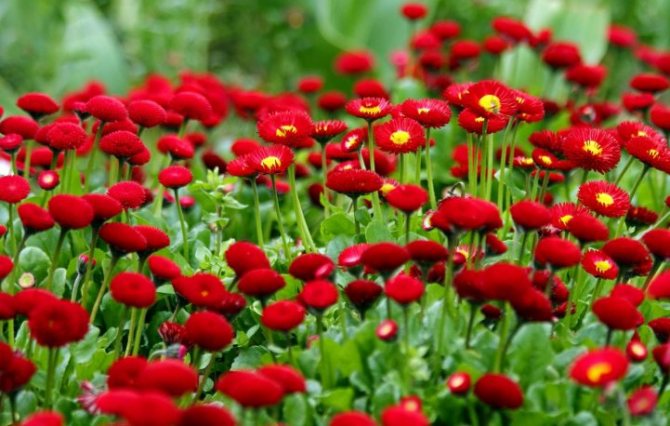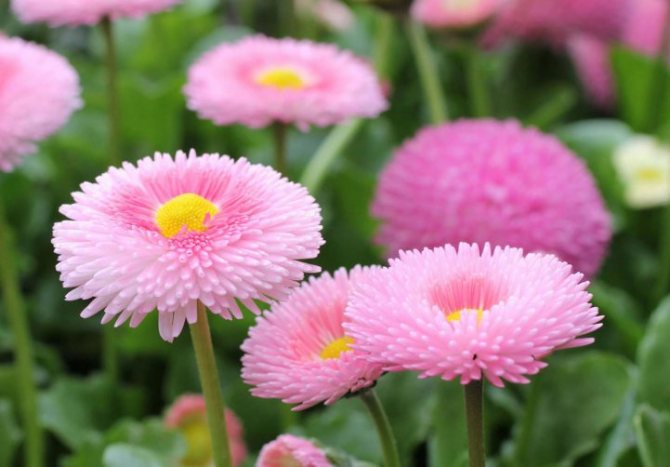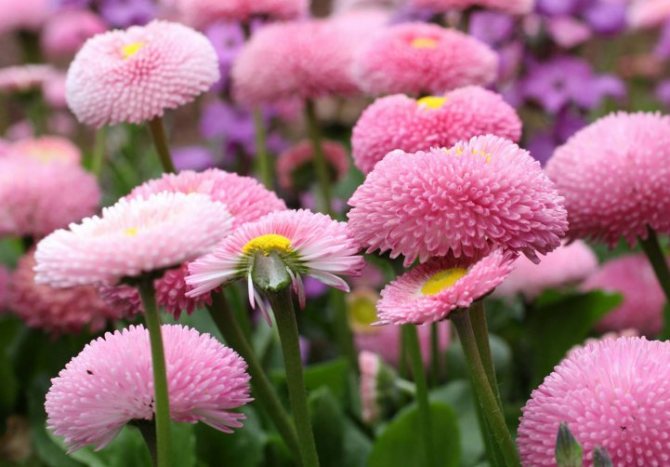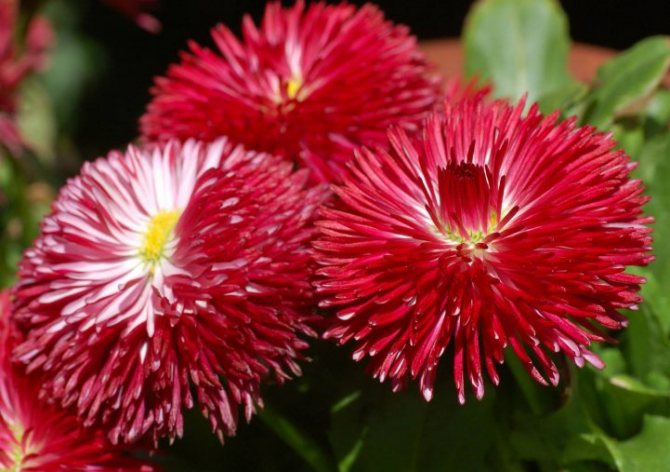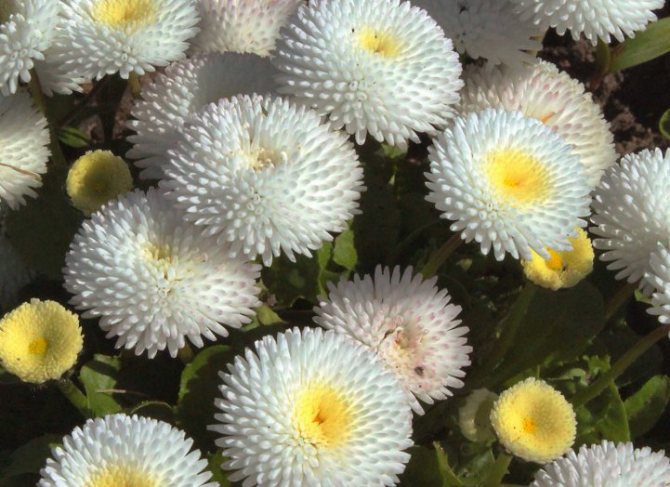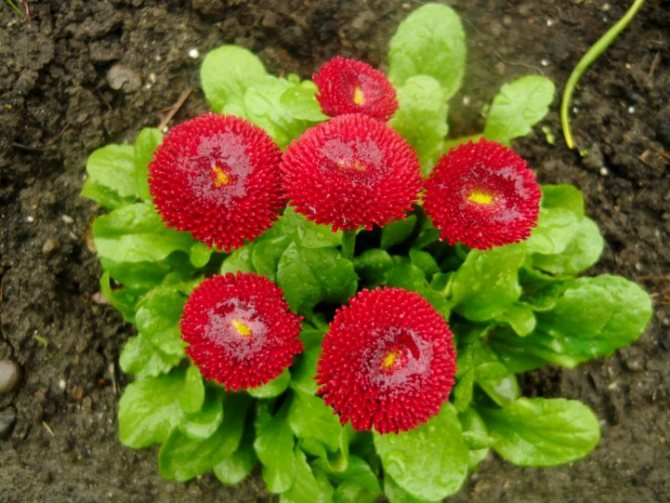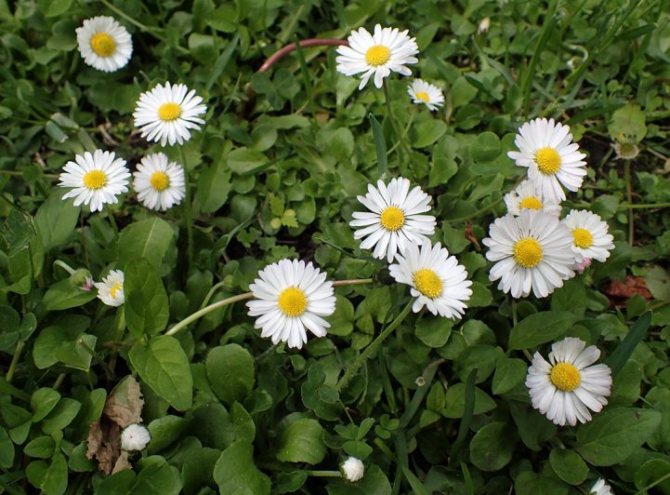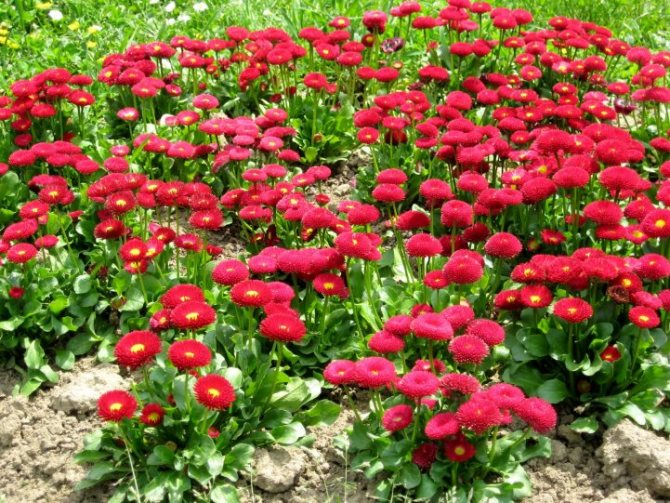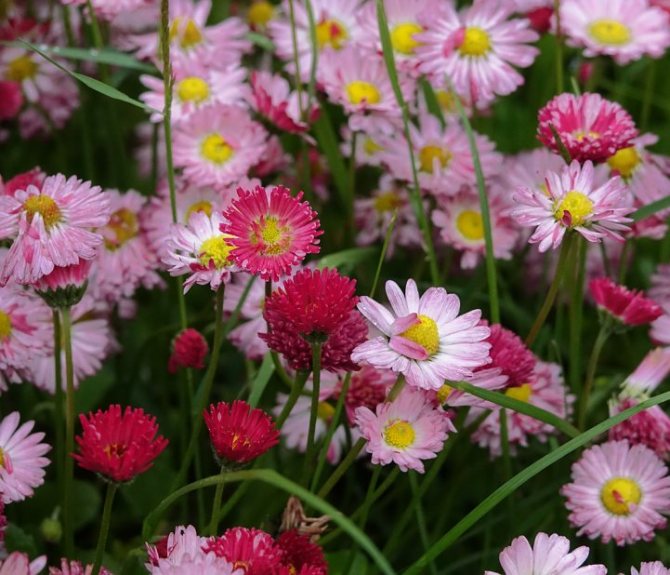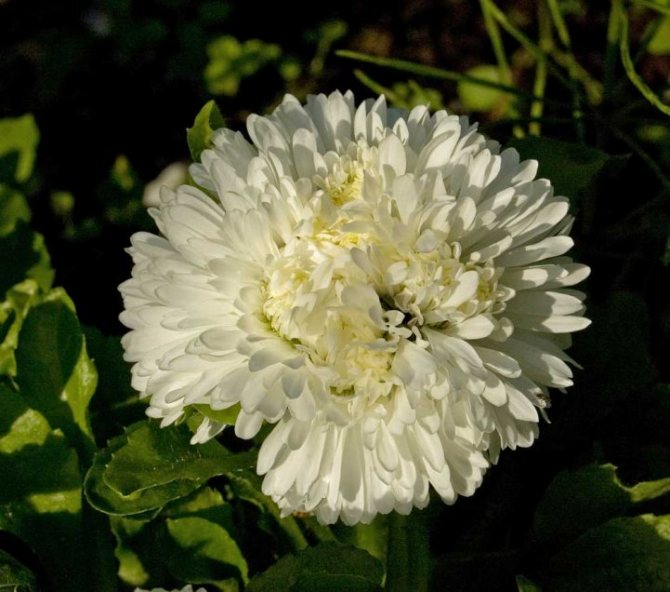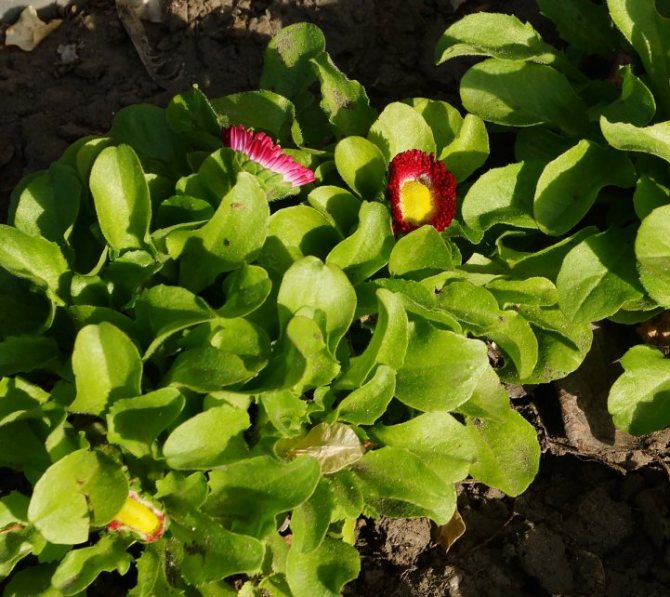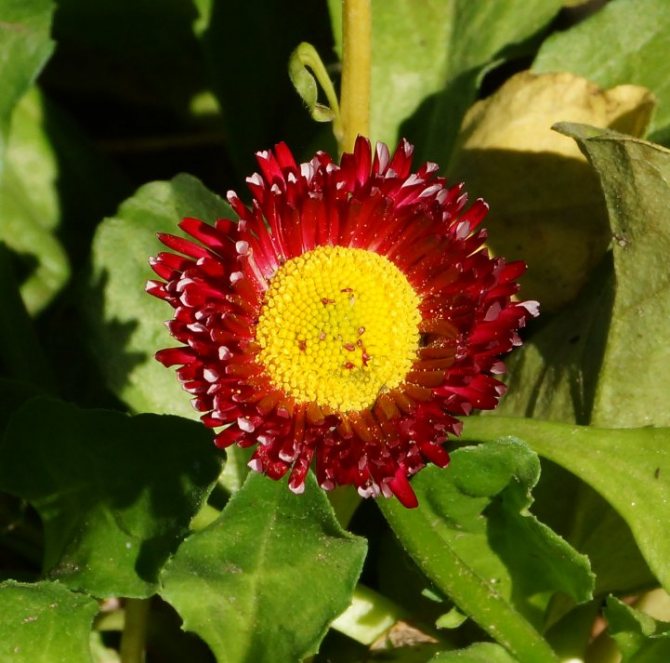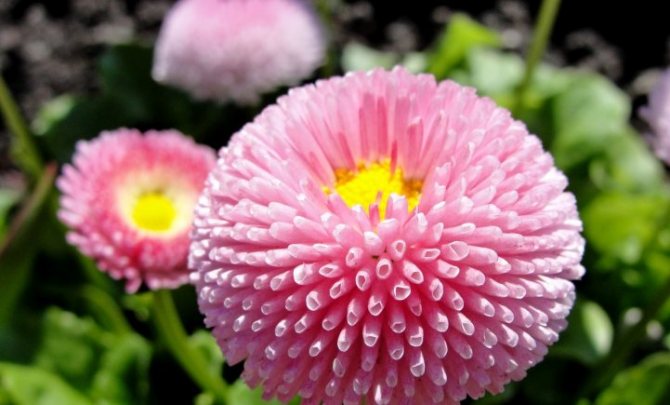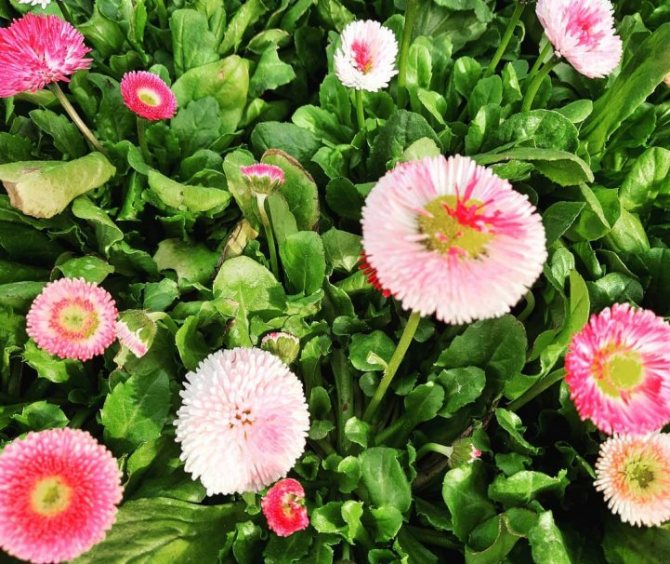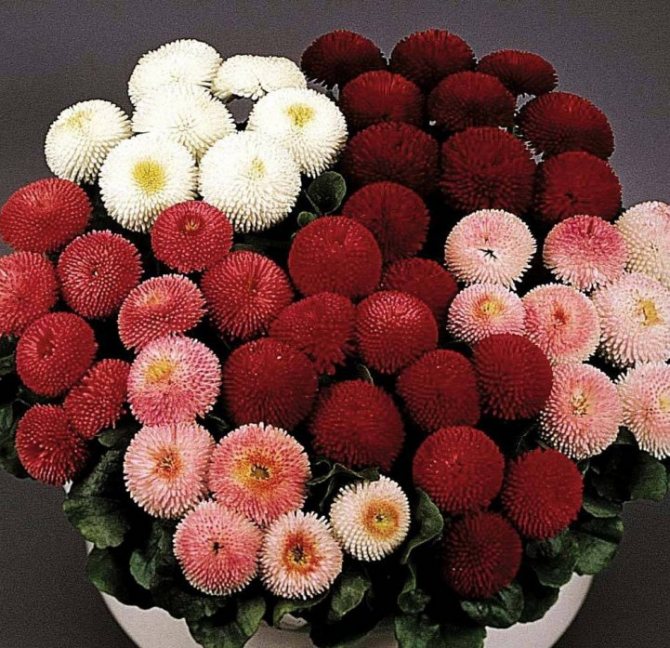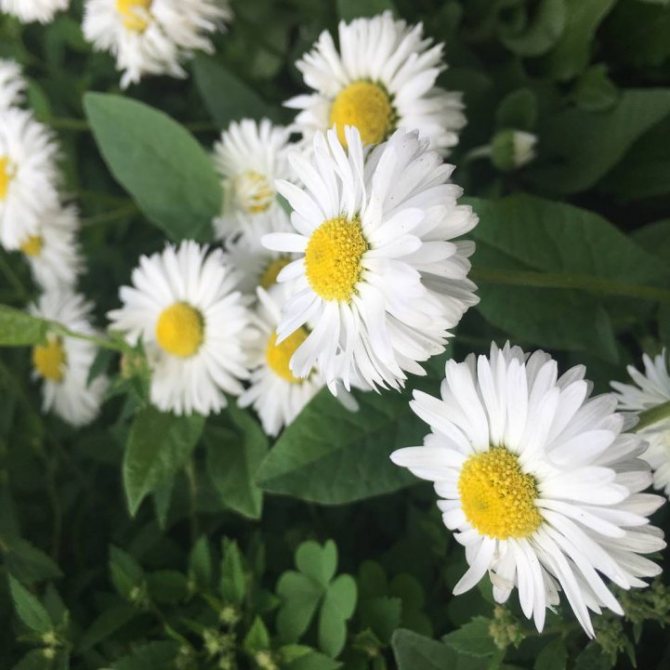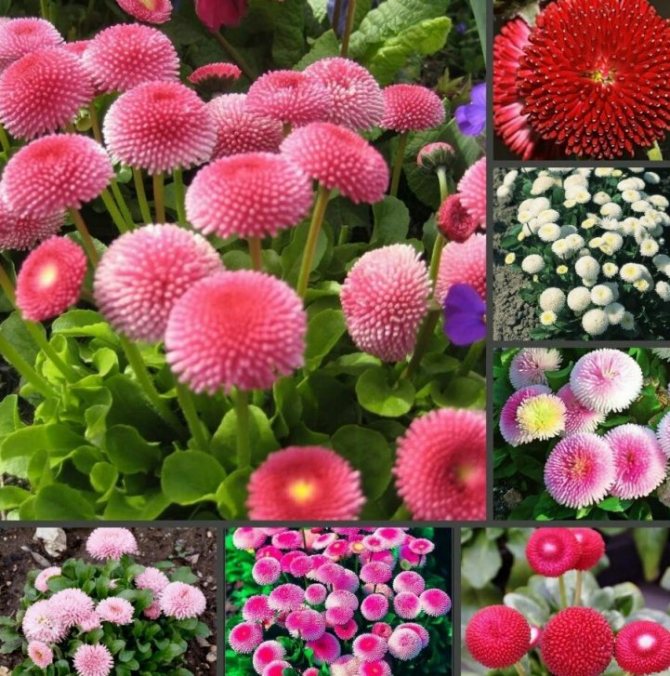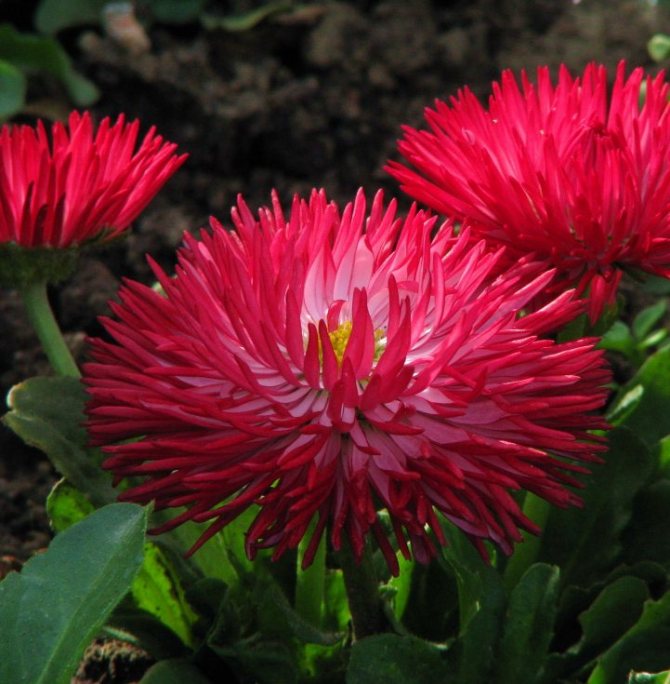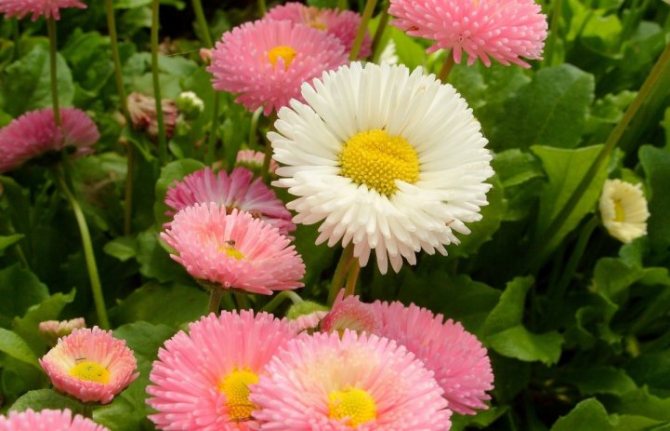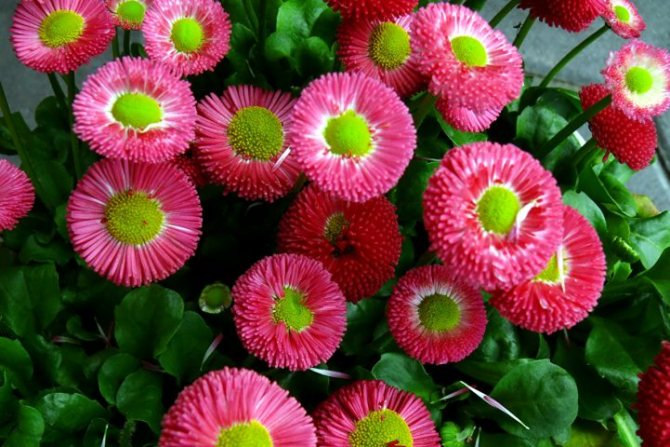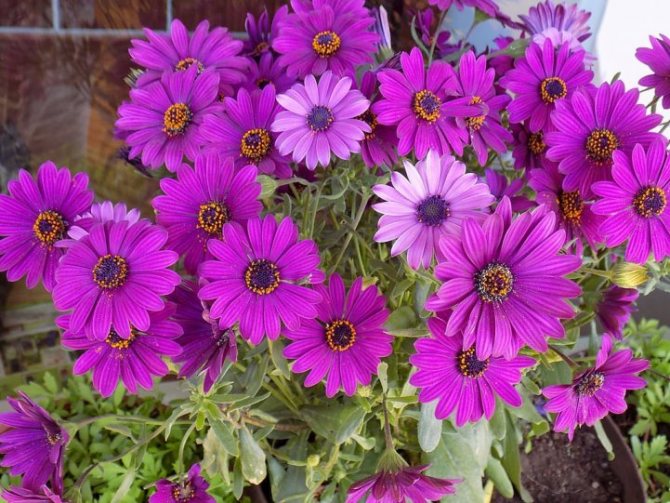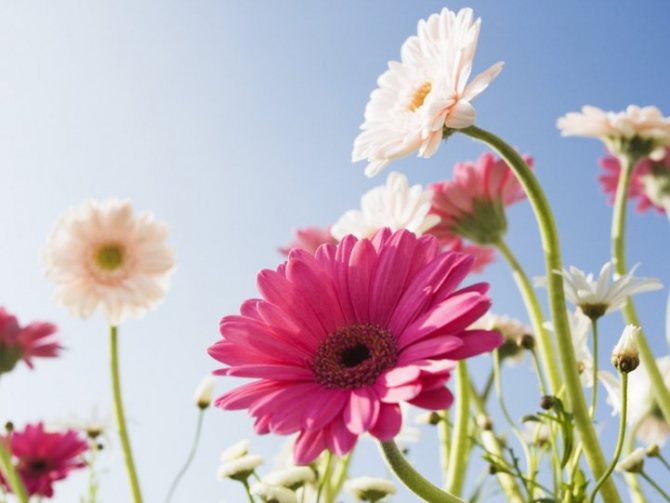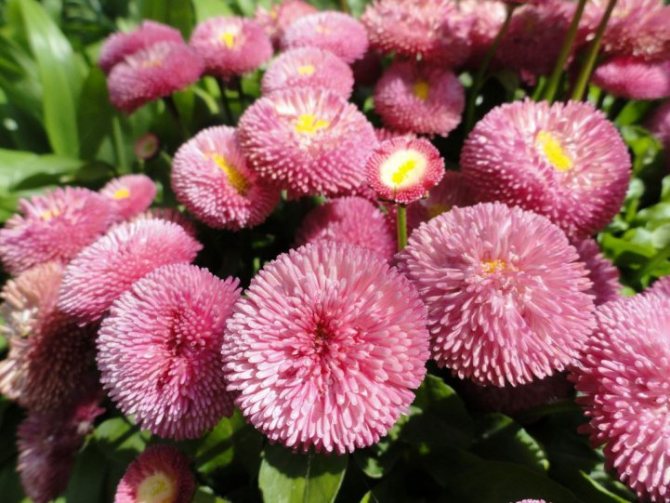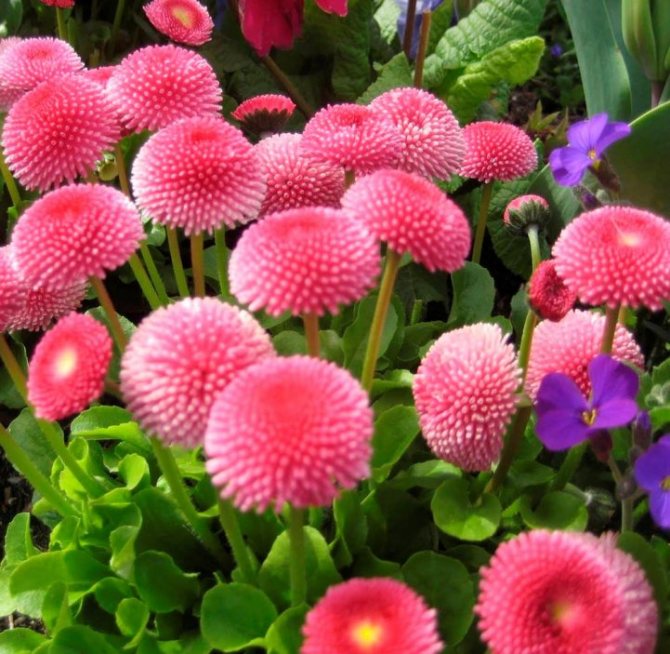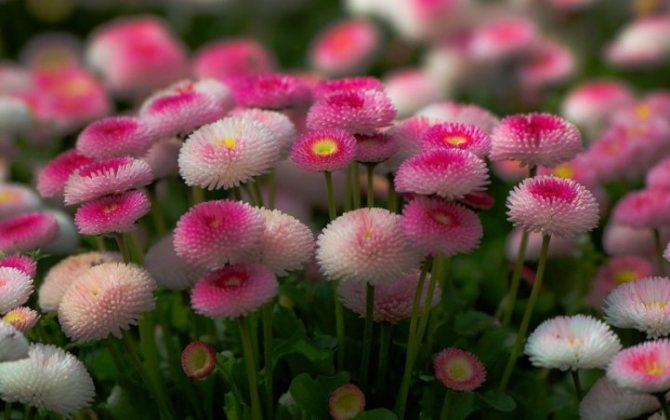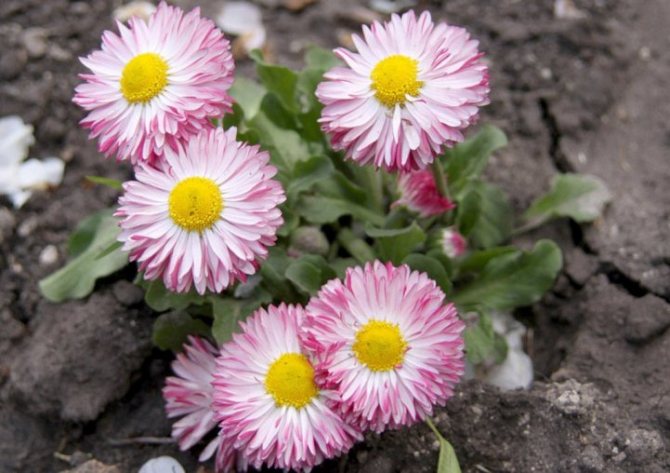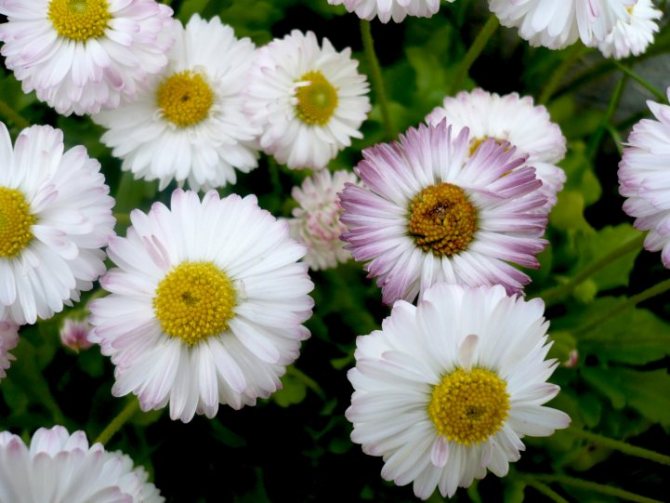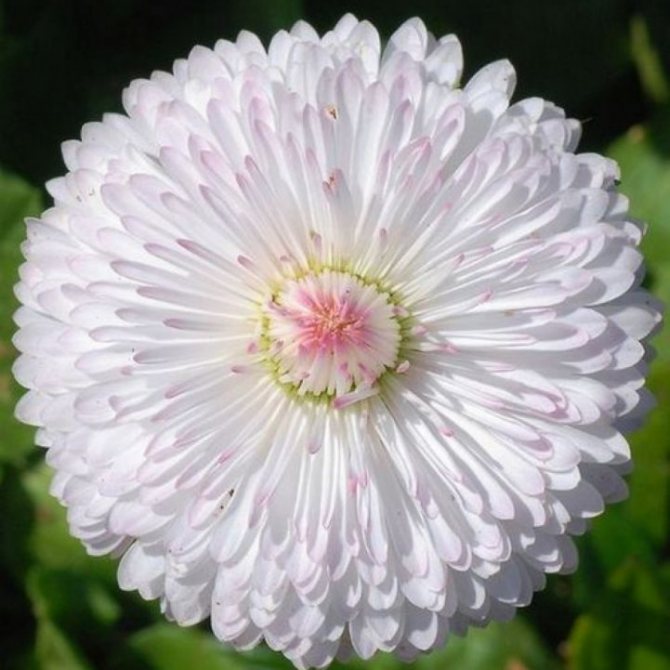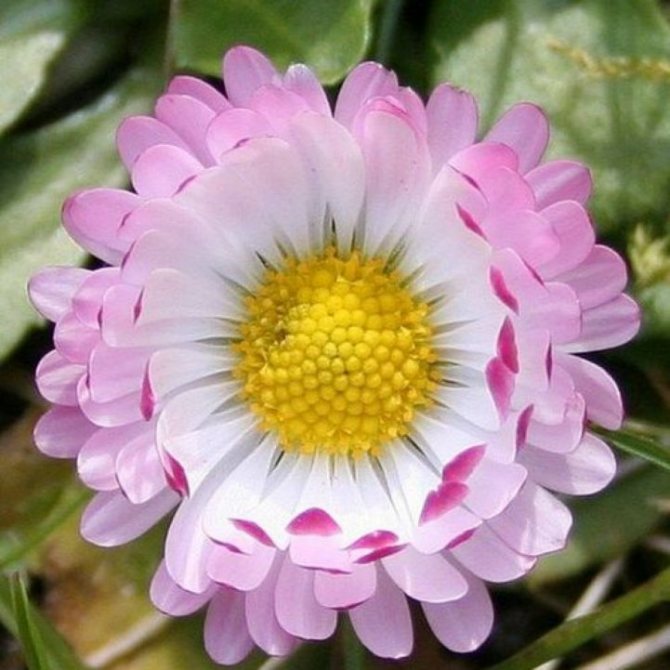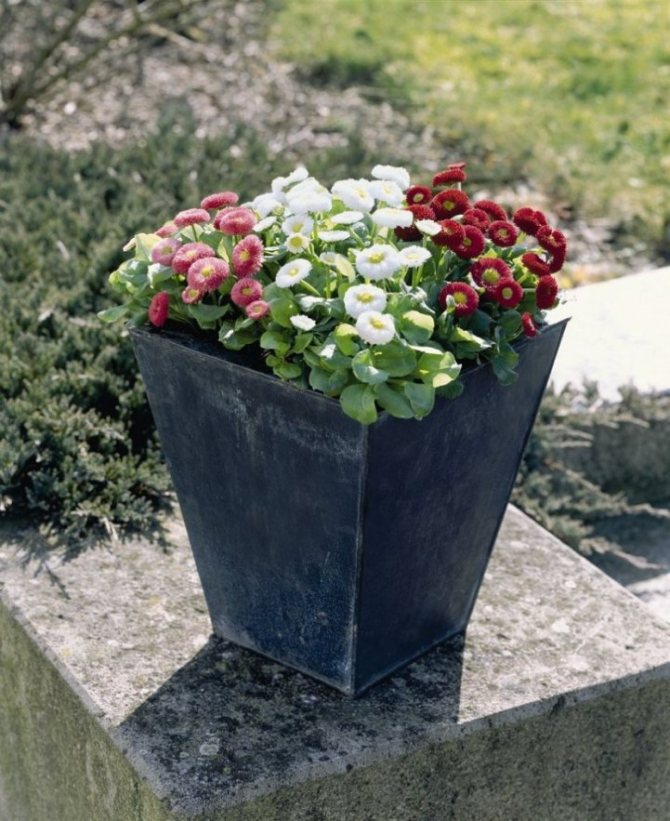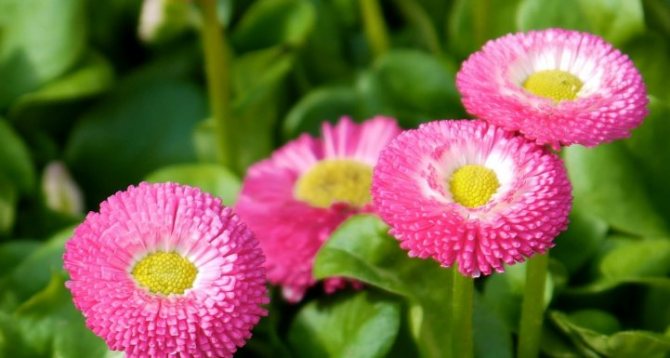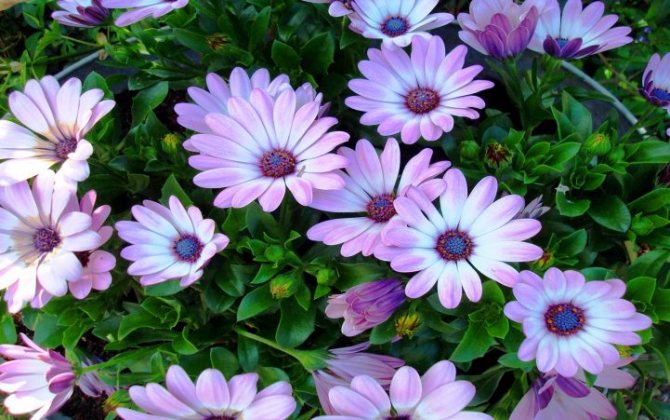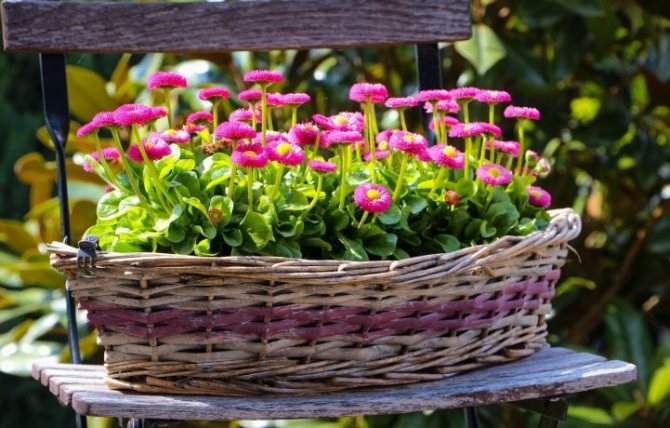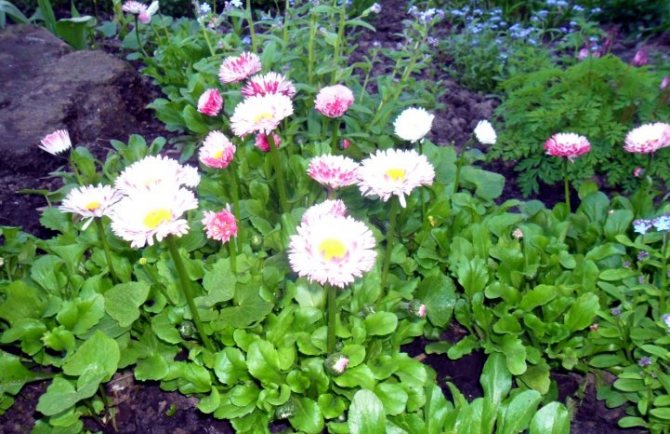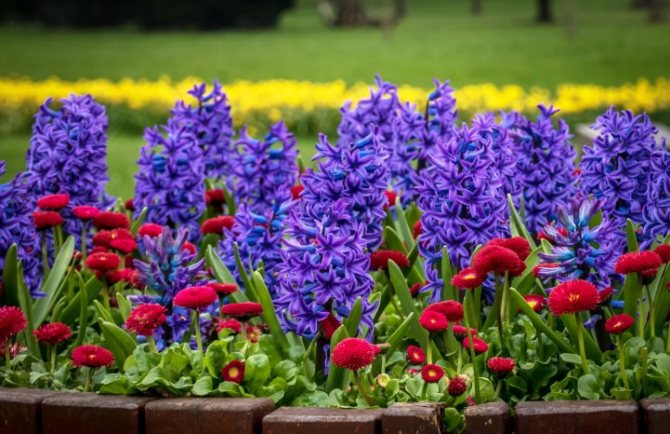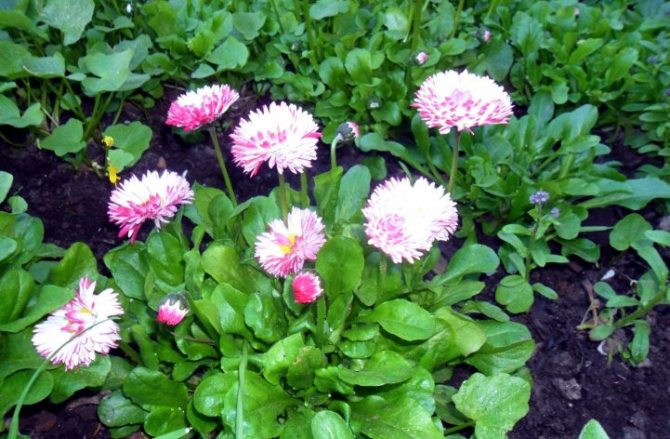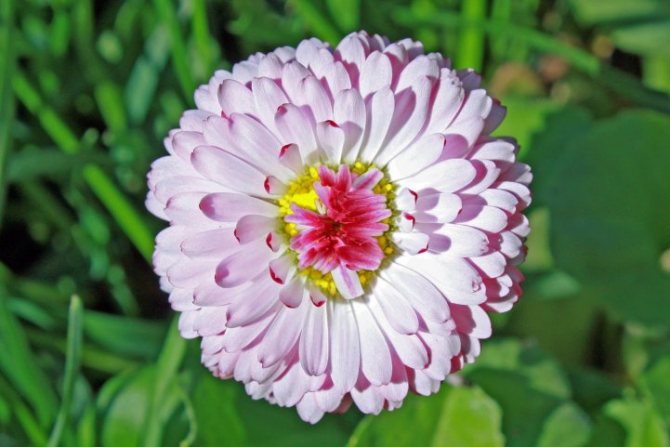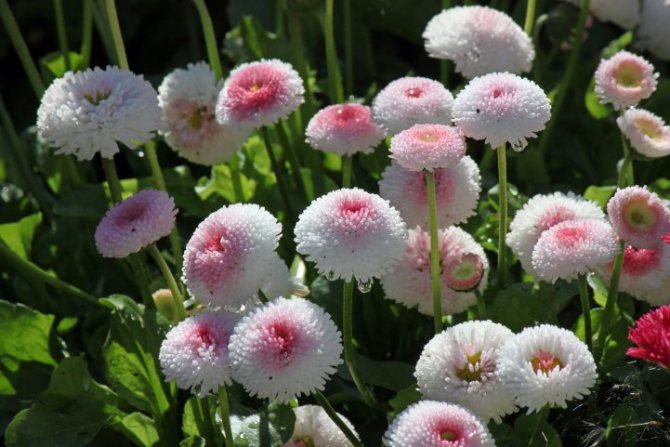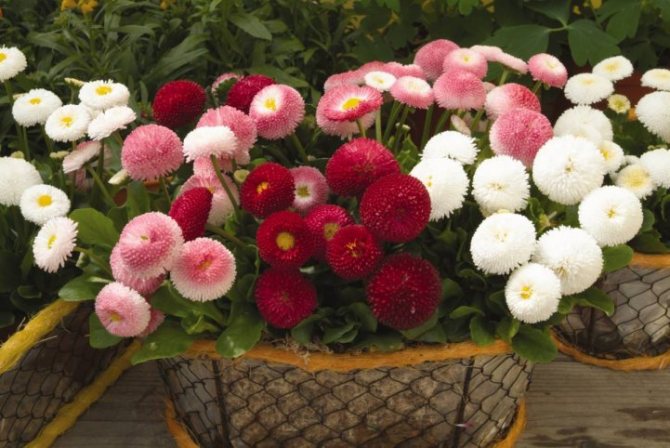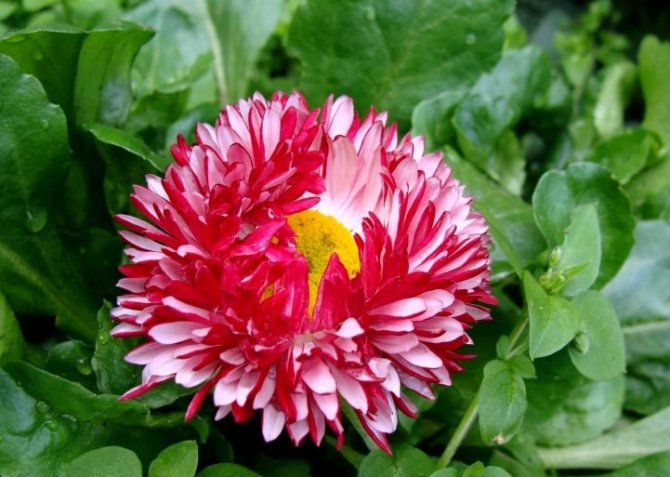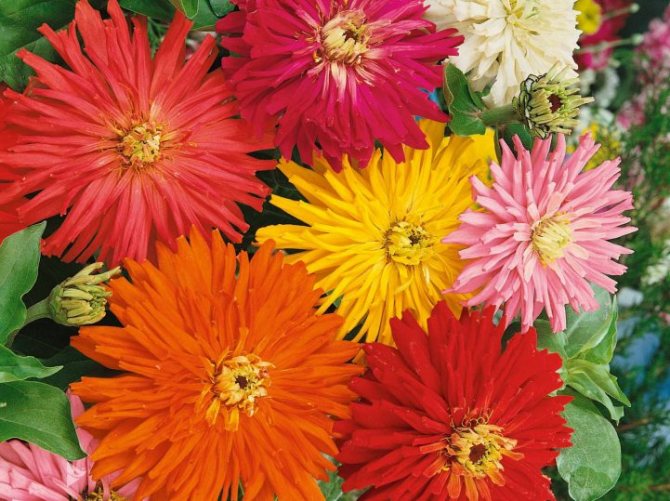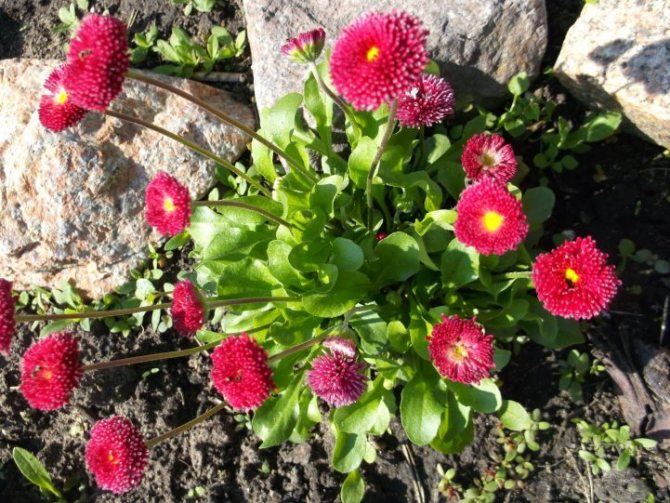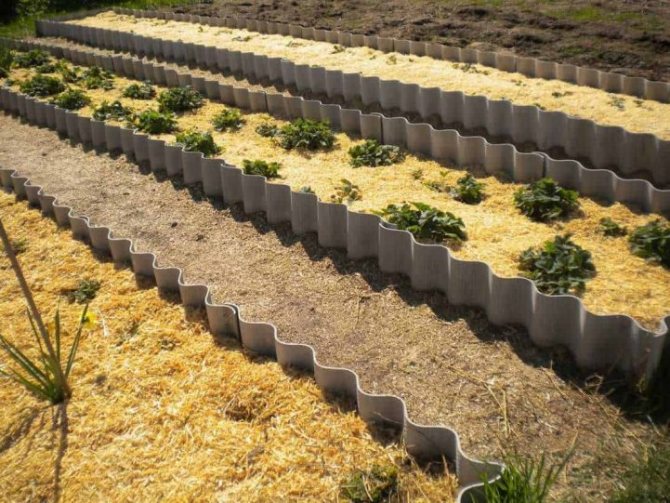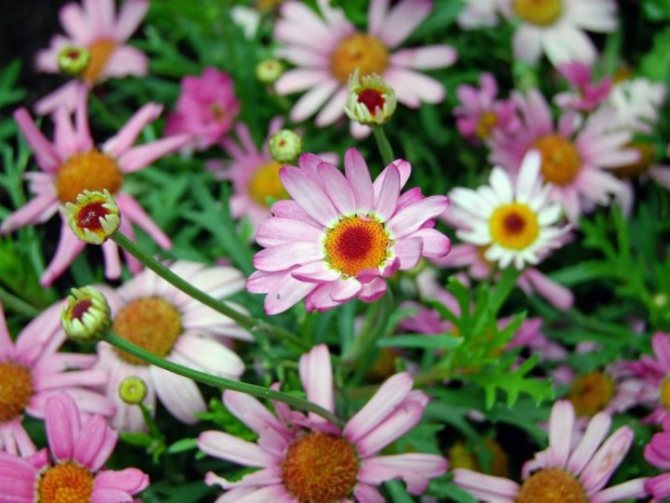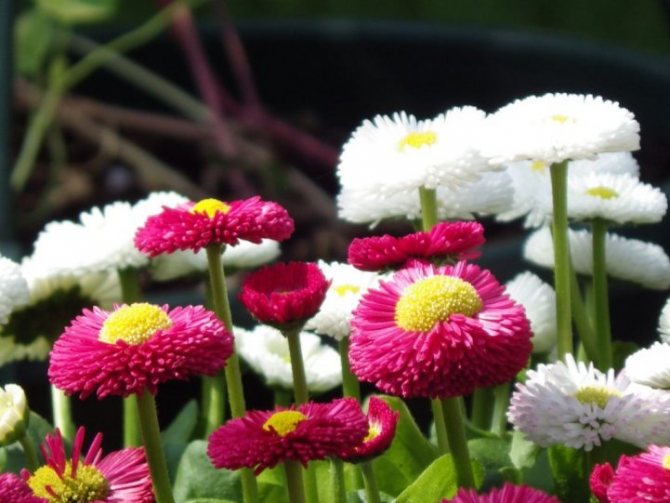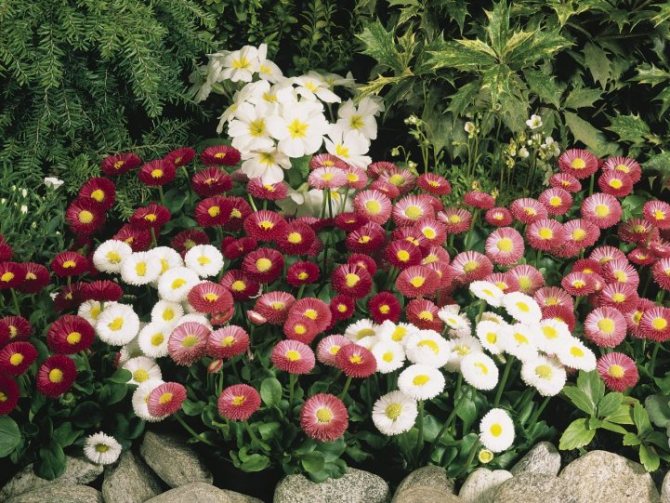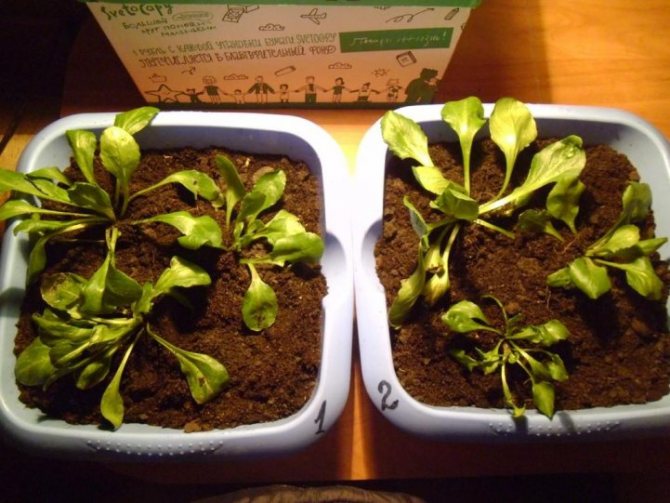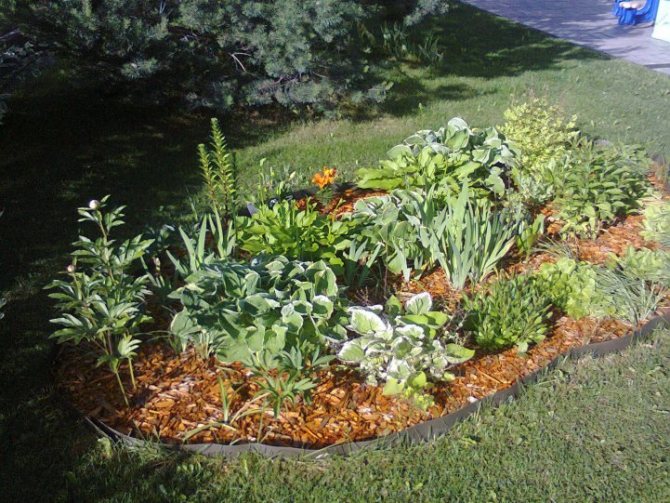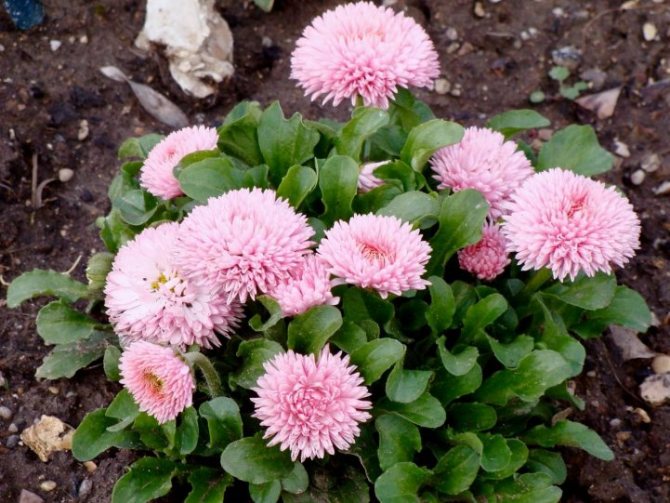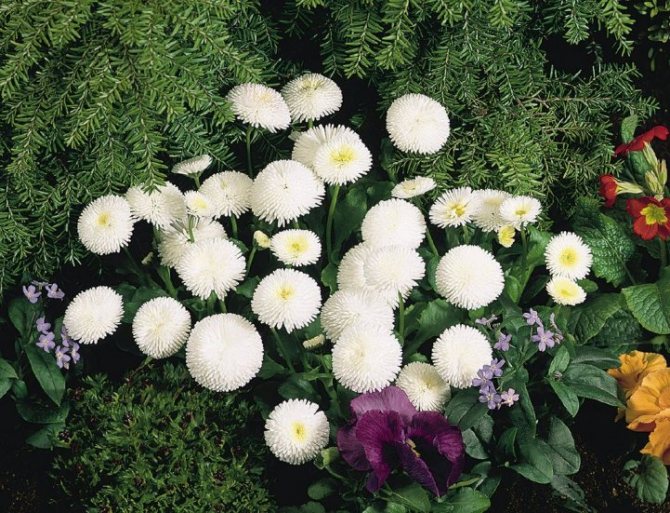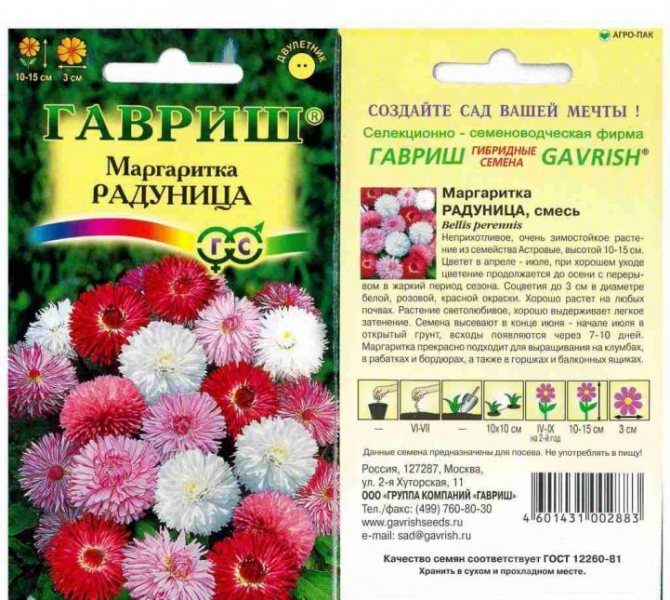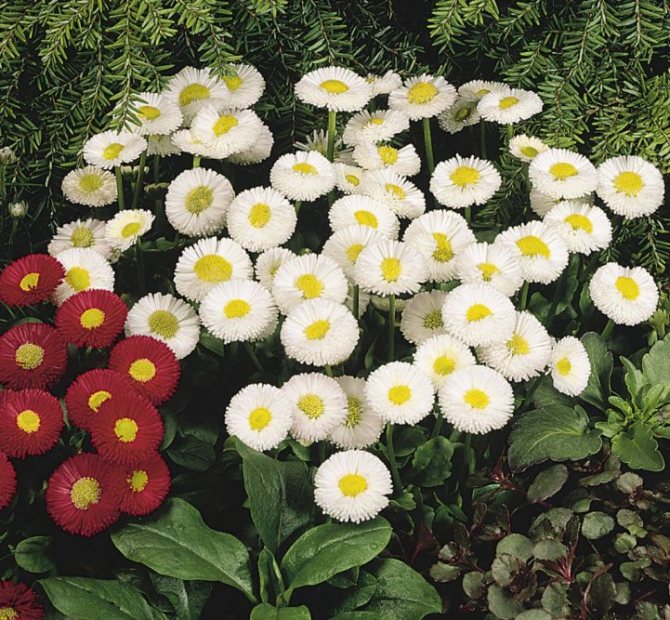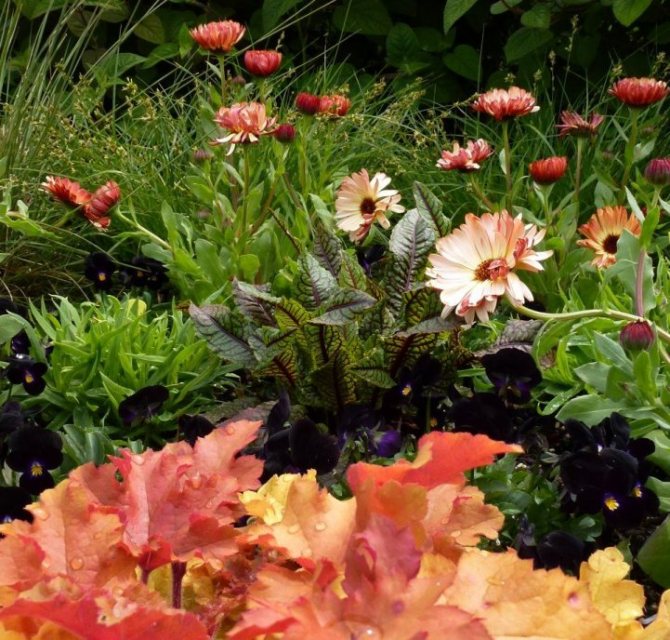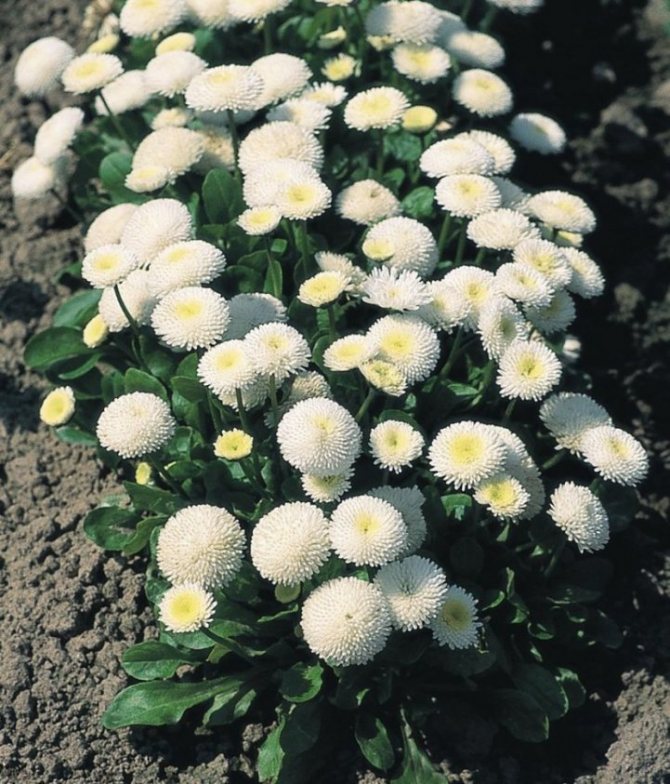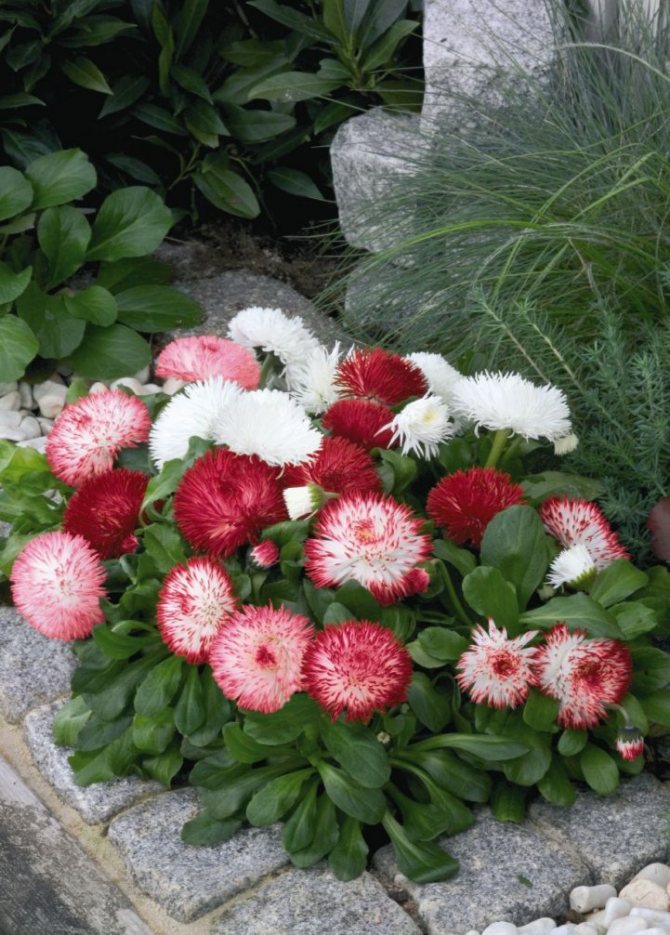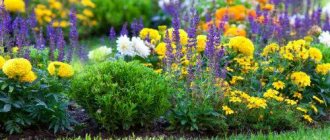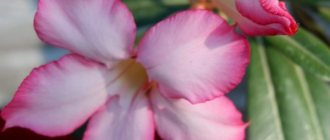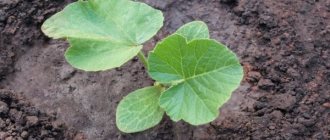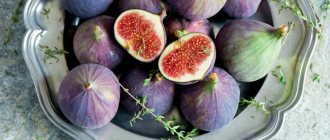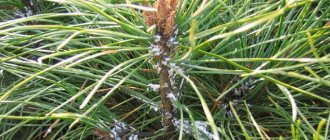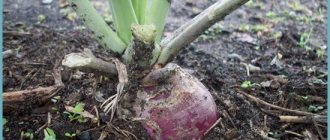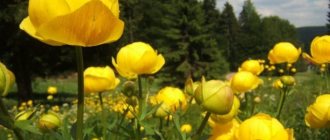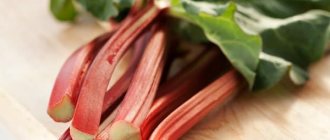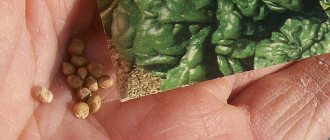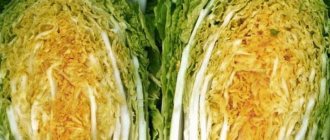Description
The name daisy translates as "pearl", which is very suitable for these flowers. Daisies are perennial or annual. Herbaceous plant. They are in the family of Compositae.
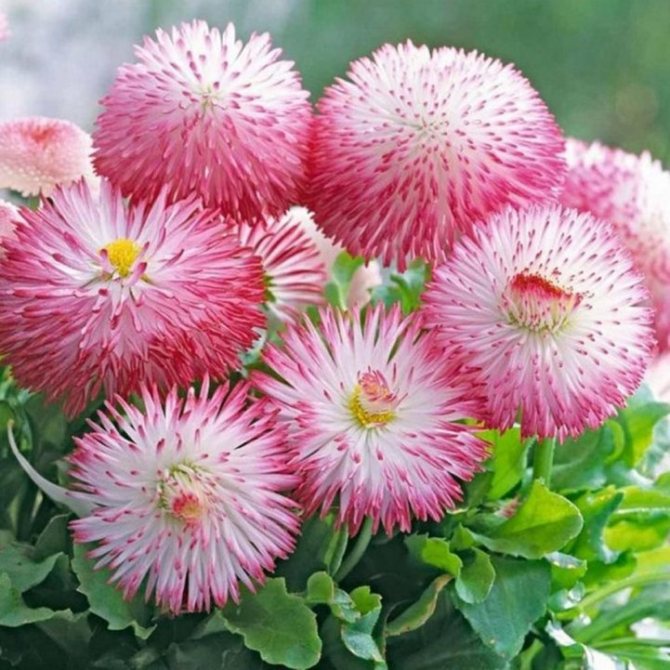
Roots
Short, located near the surface, branched, light.
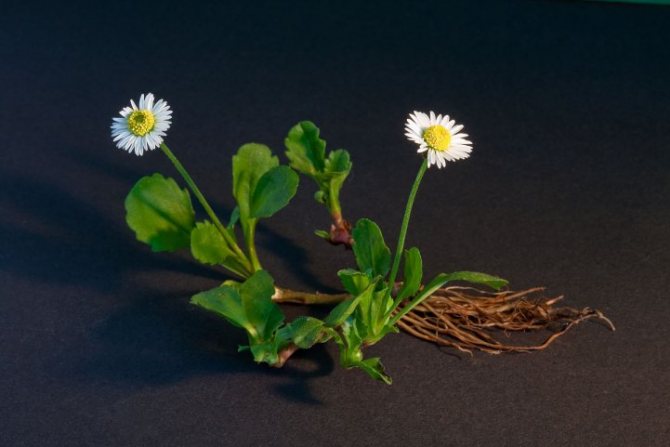

Leaves
The leaf plate is round, can be jagged at the edges, green shades. The leaves are collected in a root rosette.
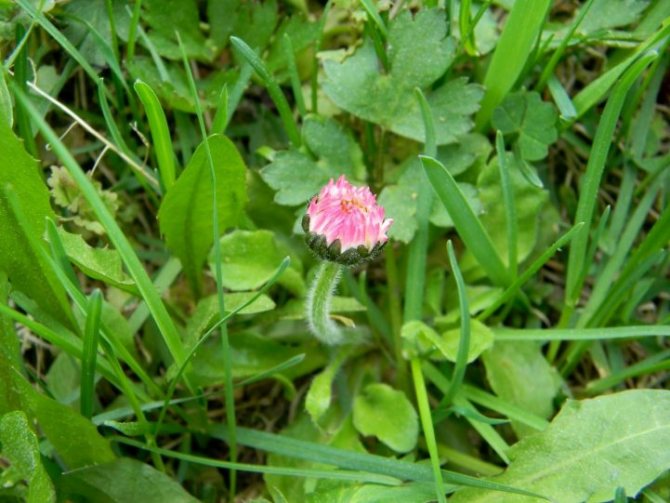

Stems
Thin, round, come out from the root without foliage, one flower is kept on them.
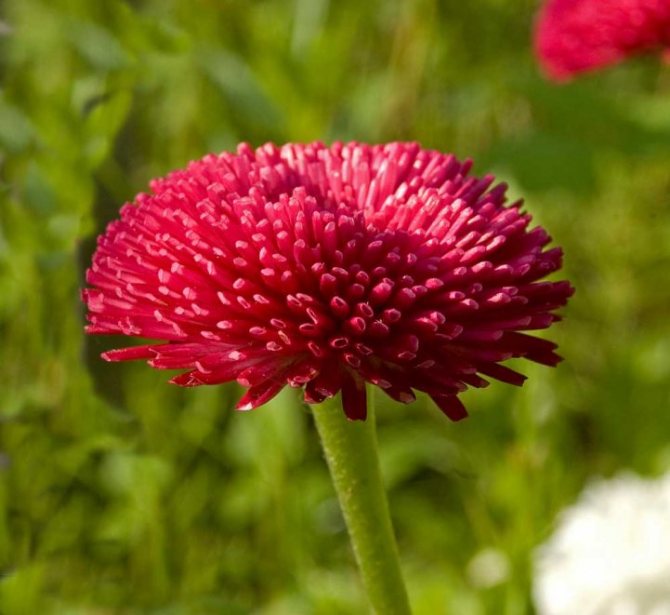

Flowers
They look like small daisies with a yellow core, they can be double, tubular. Collected in baskets. In the photo, perennial daisy flowers look like small multi-colored suns, and terry varieties resemble pompons.
Application
Daisies bloom very early - at the turn of March and April, so many people plant this spring flower in their gardens, in flower beds, in pots, and balcony boxes. It is worth decorating terraces and balconies with it in early spring. Daisies also look beautiful at home as unusual potted flowers.


In the garden
The flower of a garden daisy is double or semi-double, has a longer stem than a perennial, the plant can grow up to 20 cm. The color of flowers is very diverse, from white to various shades of pink, red and even burgundy. The flower remains on the plant for a long time, until June. Some varieties repeat flowering in late autumn.
Daisy - ideal for group plantings, goes well with other plants. It can be used successfully on the edges of lawns or flower beds. It goes well with other low spring flowers - dwarf daffodil, forget-me-nots.
An interesting suggestion is to add daisy seeds to the lawn mixture, which will create a real meadow around the house. Flowers will not interfere with cutting the grass - they will grow well again.
At home and on the balcony
The flower is ideal for balconies, terraces. Daisies look great as potted flowers planted at home. They are not too demanding on conditions, so they feel good in boxes and containers. The potted daisy is a very grateful plant, resistant to adverse conditions, caring for it is really very simple and pleasant.
To grow daisies at home with satisfactory results, it is important to water them regularly and remove faded blossoms. To decorate the apartment, the flower should be planted in multi-colored pots. Thanks to this, we will create a real spring in our home.


This flower can be planted on the balcony as early as March. Flowers look good when planted in groups. They can be used to create multi-colored compositions. They look very good in combination with other spring flowers that are resistant to low temperatures, such as pansies, and are a great addition to chamomile.
A flower planted in a container will bloom for several weeks. After flowering, it should be planted in the garden, where it will tie seeds and scatter them into the ground. Young plants will bloom next year.
Daisy care
For daisies, the rules of care correspond to generally accepted ones. Periodically loosen the soil, weed out weeds. Remove wilted flowers.
Watering at the root is carried out every week, but do not overmoisten.Every two weeks, various fertilizers are poured in, changing them as the plant grows from nitrogen to potassium.
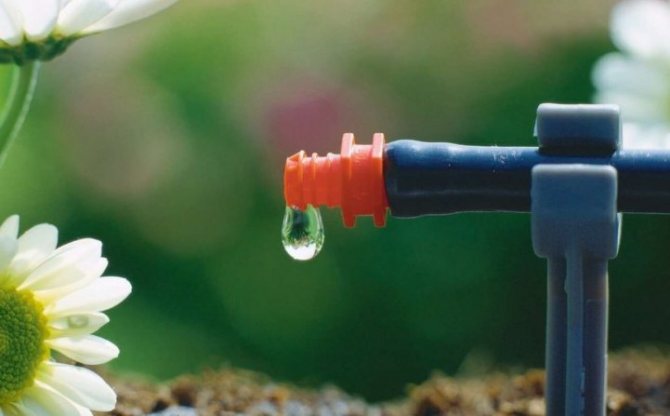

The leaves are examined. If pests or discoloration are noticed, insect and virus control solutions are used.
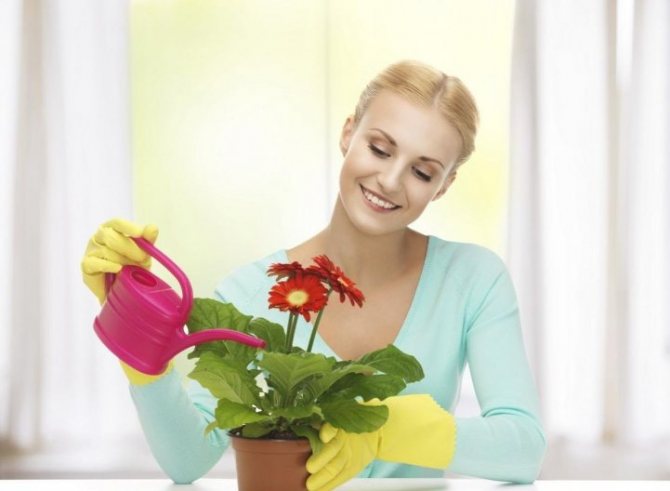

What does a flower look like
Daisy inflorescences have the shape of a yellow basket, up to 4 cm in diameter, therefore, the flower itself can be small and larger.
- The colors of the petals are very diverse - these are white, pink, red, simple and velvety flowers.
- The structure of the petals is either lingual or tubular.
- You can observe the flowering of a daisy from spring to autumn, for the middle lane, May - October.
But this does not happen due to the preservation of flowers on one plant, but due to the formation of new shoots.
In fact, the daisy blooms until mid-summer, then the seeds are sown and new representatives are formed. Thus, the lawn continues to bloom. Unfortunately, new flowers do not adopt the qualities of their parents.
Daisies with velvety large flowers are used to create chic bouquets.
Pests and diseases
It does not get sick often, but various pathogens and pests can create problems for the plant.
Powdery mildew. White spots appear on the leaves, they are removed and burned, the plant is spilled with fungicides. Reduce humidity, as this is one of the signs of damage to daisies.
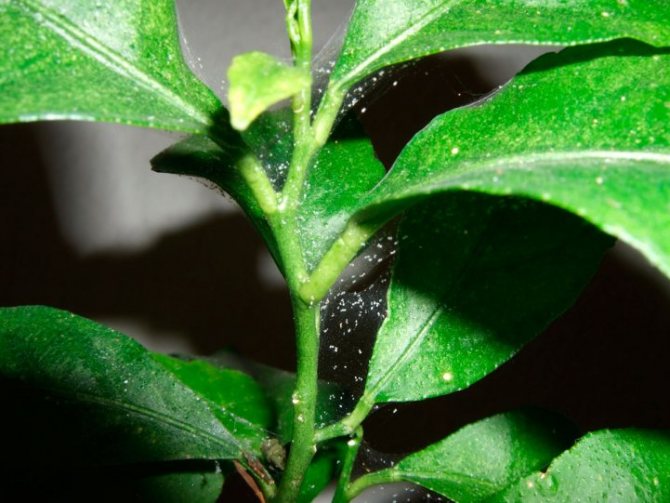

Gray rot. Also occurs when waterlogged. Roots and plants are treated with special antibacterial drugs. If the disease is started, the plant is removed.
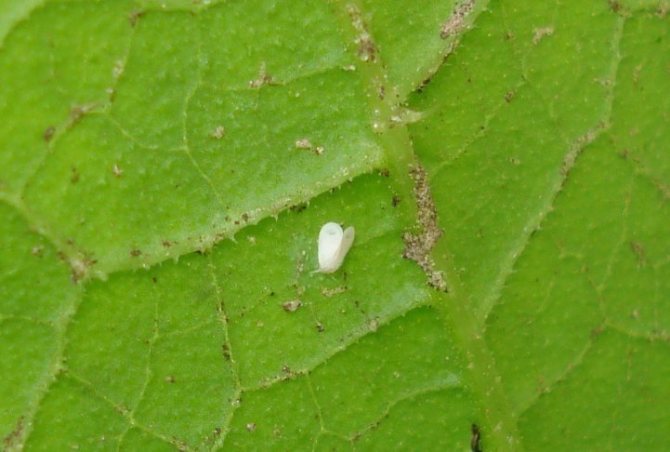

Ticks. They drink daisy juices. It is necessary to inspect the plants and apply means to control them.
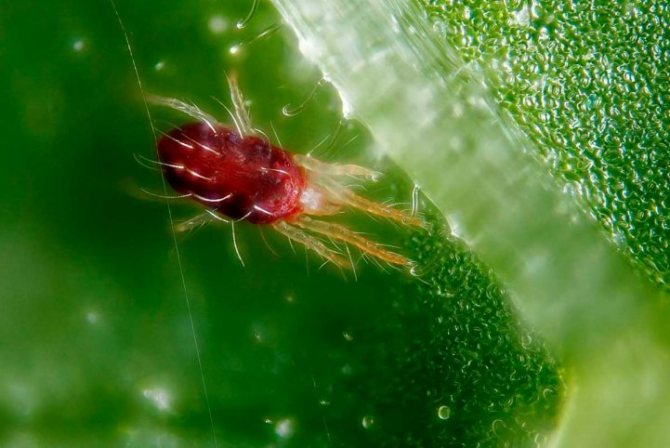

Planting daisies outdoors
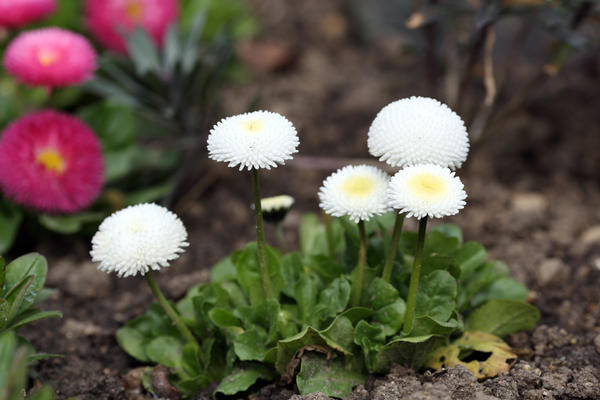

What time to plant
Daisies are light-loving plants; therefore, a well-lit area must be chosen for them. This culture is not demanding on the composition of the soil. You can plant seedlings in absolutely any garden soil. However, it will grow best on structured light loam. For planting, places located in the lowlands are not suitable, where there is stagnation of melt or rain water, the fact is that such plants react extremely negatively to excessive soil moisture.
The grown seedlings are planted in open soil in the last days of May or the first in June.
Landing features
It is necessary to plant a plant in the soil together with a clod of earth. To begin with, you should prepare holes for planting not very large, the distance between them should be equal to 20 centimeters. Seedlings should be planted in them using the transshipment method, while trying not to damage the roots of the plants. The soil surface around the bushes must be well compacted, after which the planted daisies are watered abundantly.
Types of daisies
Since daisies are annual and perennial, consider the types of both.
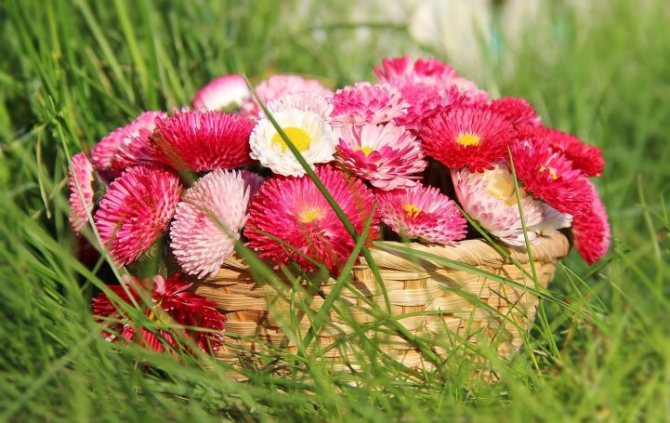

Annual daisies
They are planted at the beginning of the growing season; they are not dug up in the fall. They bloom about 60-70 days after planting. Propagated by seeds, which are planted in early spring at home or in a heated greenhouse.
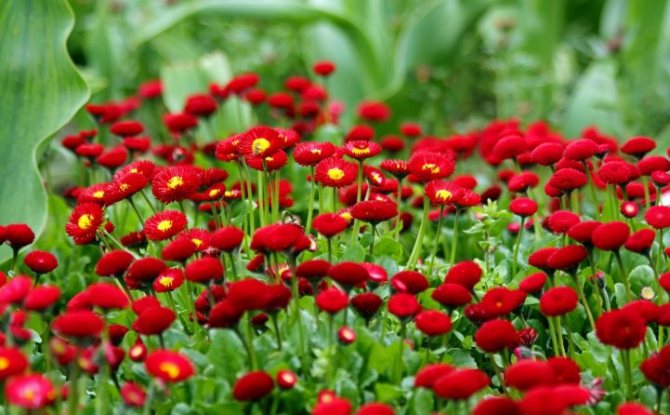

Perennial daisies
The types and varieties are more diverse. After examining the photos of perennial daisies and reading their descriptions, you can make a beautiful composition on the lawn or on an alpine slide.
Speedstar
The height of the bush is 10-12 cm, the baskets are carmine, closer to the center are white, the center is egg-colored.
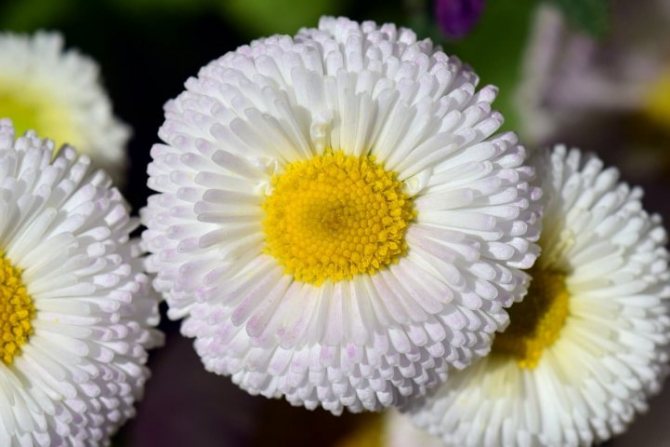

Tasso
Pink and white flowers, covered with a huge number of tubular petals, huge in size.
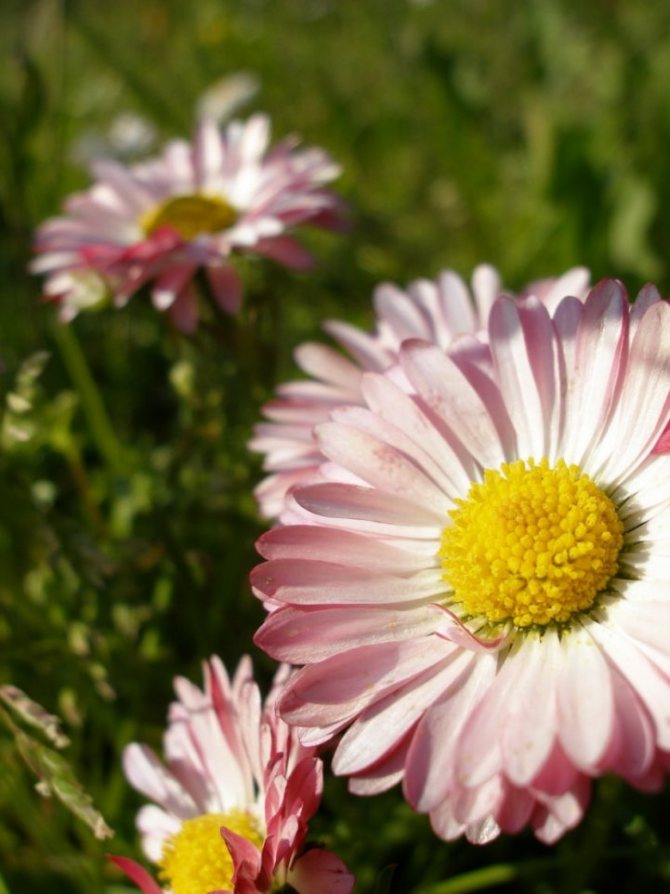

Habanera
Delicate flowers with slightly curved petals. Inflorescences half red, half milky
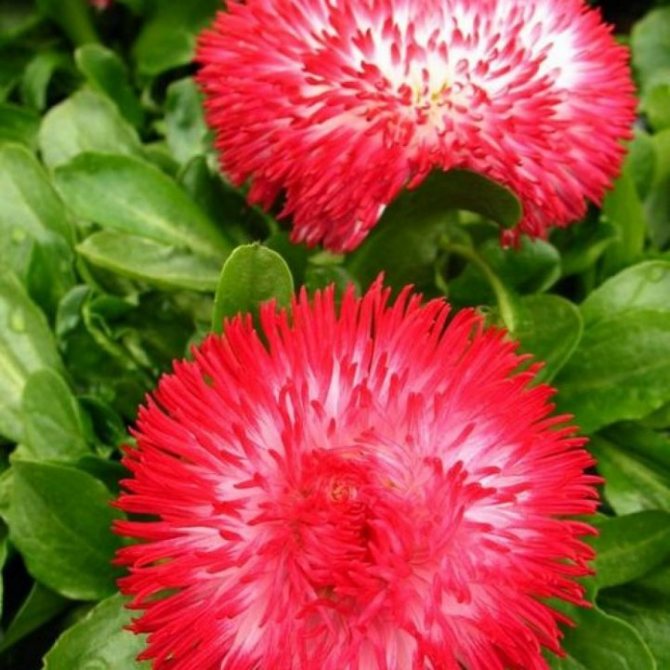

Robella
Large flowers up to 5 cm, salmon shade.
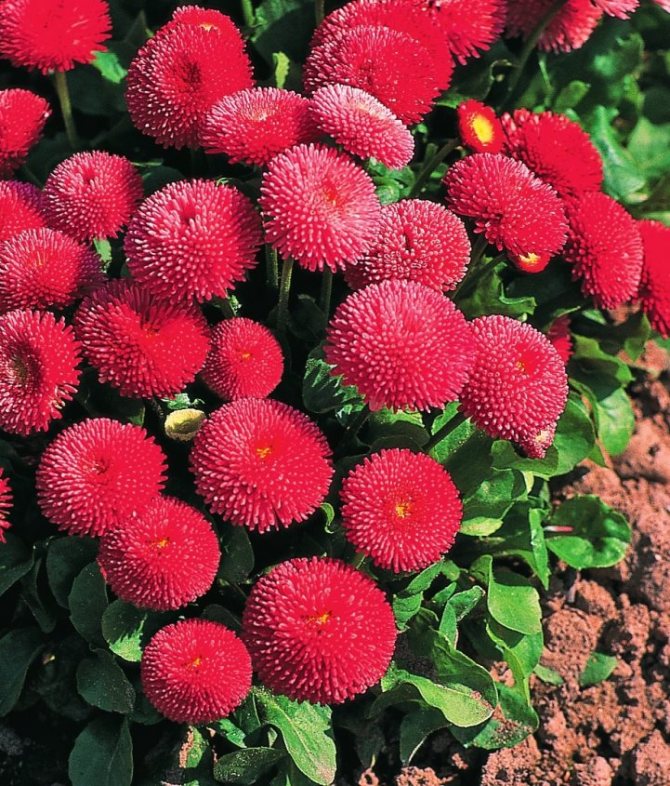

Bellissima
Forms pompons, with an amber center, large 4.5 cm.
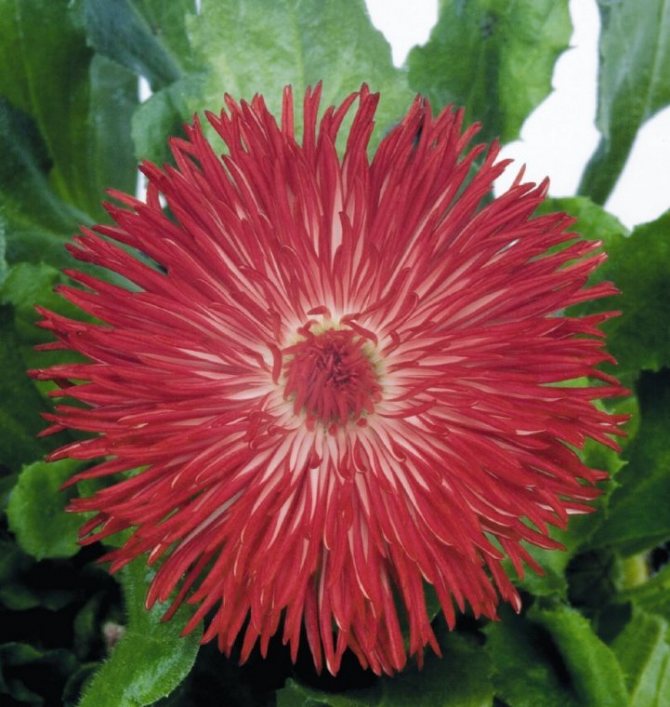

Belladaisy
Small, light red flowers with a yellow center, blooms 100 days after planting in the first year.
Pomponette
One of the first cultivars bred, the name speaks for itself, a profusely flowering plant, at the same time it can have 20-30 heads.
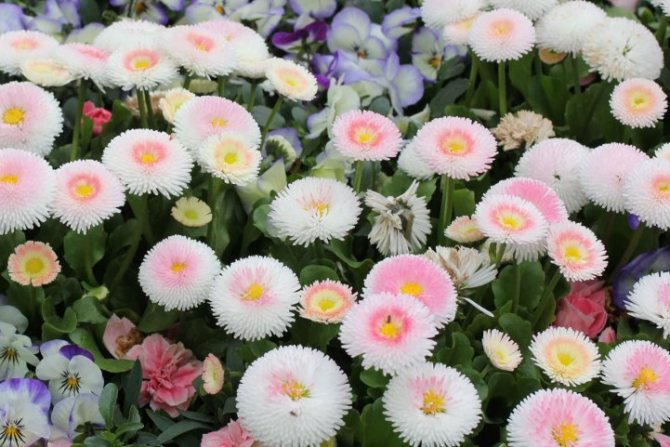

Rominette
Strongly terry, reaching red, the height of the bush is 15 cm.
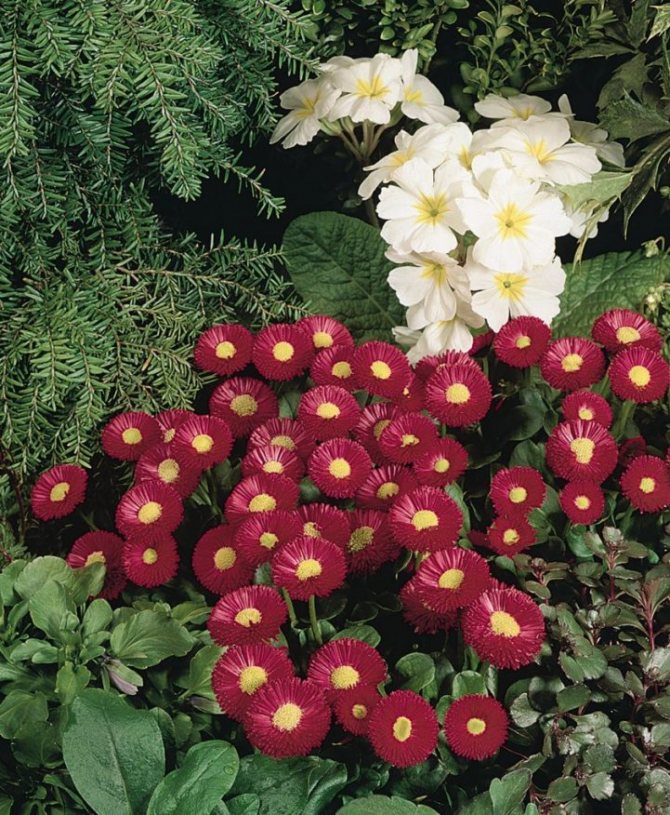

The flowers of the perennial daisy are rightfully called the "pearl", she deserves it. Scatter seeds on the lawn and you will see a miracle.
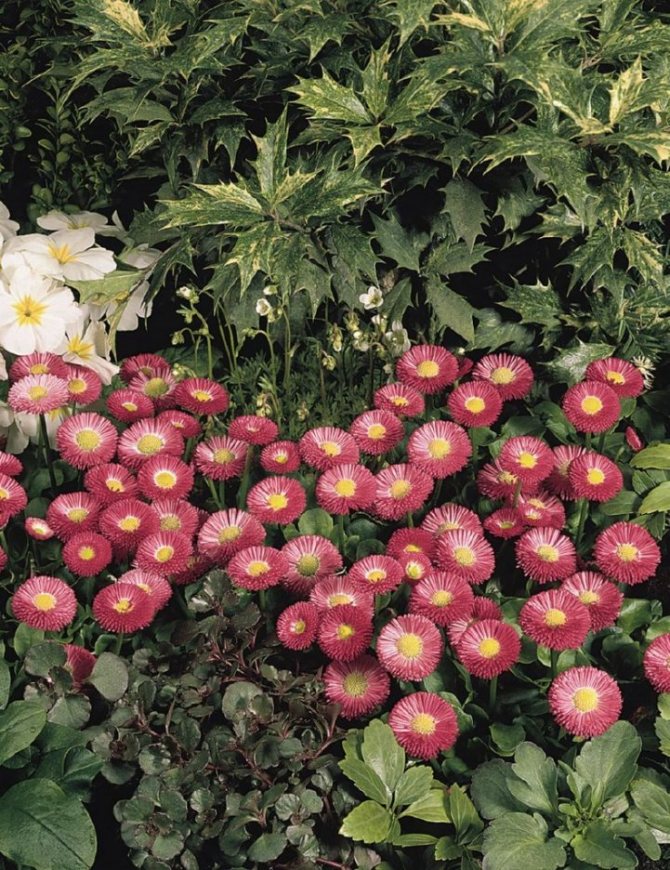

Reproduction
Garden daisies are usually bought in garden centers as an already blooming spring flower. However, it is worth trying to grow your own daisies from seed or vegetatively.
Seeds
So you can get many young plants, which next year will become a real decoration in the garden, on the balcony.
Seeds for planting are best purchased from a gardening store They are obtained by selection, and thanks to this we get exactly the plants we want.
When is the best time to sow daisy seeds? The best time for sowing seeds is June, then they will have time to grow before autumn. The ideal temperature for seed germination is 18 ° C.
The seeds are sown in the garden as follows:
- For seedlings, a small area is prepared, which is pre-cleared of weeds, the earth is loosened, dug up, while adding compost.
- The soil is carefully leveled with a rake.
- Shallow grooves (1 cm) are made and seeds are sown in them.
- The seeds are covered with a not very thick layer of soil and keep the soil moist. Do not forget to regularly weed the seedlings.
- When the plants give 3-4 leaves, we dive them one at a time to provide them with the best conditions for further development.
- At the end of August - September, the young daisy is ready for planting at its destination. Daisy seedlings are planted in a permanent place at intervals of 20 × 20 cm.
- For cultivation to be successful, young plants need to be protected from frost for the winter. For shelter, branches of coniferous trees are used.
Plants obtained in this way can be used to decorate the borders of flower beds, paths, lawns. They will be great as potted flowers and will be a great decoration for your balcony and home. Garden daisies grown from seeds will bloom next spring.
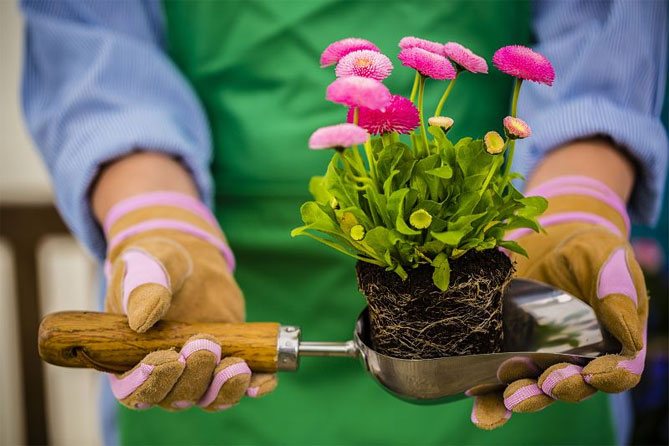

Vegetatively
Daisies can be propagated vegetatively. To do this, in the spring, the shoots that produce the mother bushes are separated, planted in the ground and placed in a warm place. Young plants need to be watered regularly. To create optimal rooting conditions, it is worth using a film tent, which is placed over the seedling pot. This will limit the evaporation of water and ensure a constant moisture content in the substrate. The seedlings take root quickly, and young plants will appear in a few weeks.
Daisies can be propagated by division. Carefully dig out several rooted sockets. It is necessary to dig up the plants along with the entire root system, which goes quite deep into the ground. After moving to your destination, you need to make sure that the pits are deep enough - all roots must be hidden in the ground. It is better to pre-prepare the holes in several places on the lawn, pour soil for flowers into them. After that, tiny flowers are planted in the pits.
A dozen new flowers should appear next year, which will reproduce consistently every year. New plants can be brought into the garden from natural meadows, they are extremely resistant to weather conditions, are not afraid of frost, and the flowering period is really long.
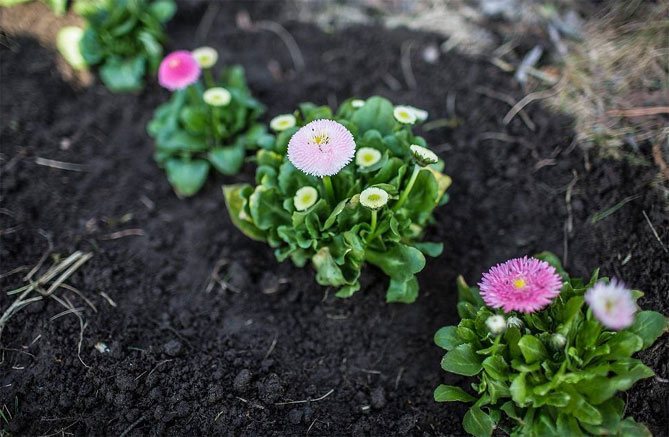

Photo of a perennial daisy
Did you like the article?
0
Growing daisies from seeds
Sowing daisies
Species daisies reproduce well in a generative way. Daisies are sown with seeds in June, without covering them directly into the moist soil, but only lightly sprinkling them with sand or sifted humus, since the seeds need sunlight and a temperature of about 20 ºC for germination. Under such conditions, the first shoots can be expected in a week.If you cover the unoccupied crops with a transparent film, the embryos are activated, and the planting depth will no longer matter - the seedlings will appear anyway. After two days, the film can be removed, and the crops can be lightly sprinkled with soil.
- Comfrey: properties and indications, planting and care
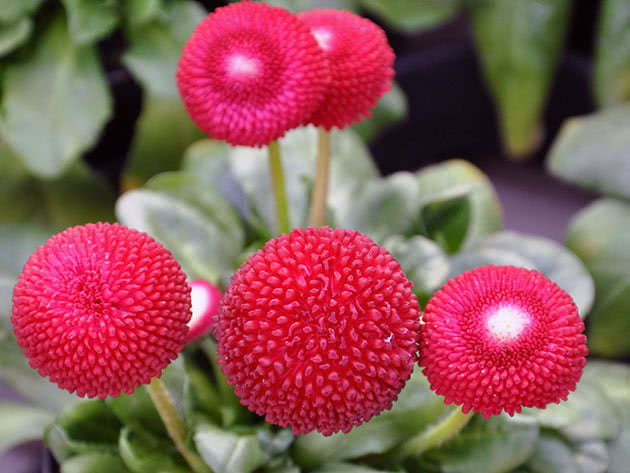

Seedlings develop very quickly, so soon they will need a pick, which is carried out directly into the open ground according to the 20x20 scheme. Daisies from seeds will bloom only next spring, since this year they will only have time to grow rosettes from leaves. Daisy also reproduces by self-seeding - in the spring you will only have to thin out the seedlings, removing weak or unhealthy seedlings, but with such independent reproduction over the years, the inflorescences become smaller and lose varietal qualities.
Daisy seedlings
Many people prefer to grow daisies in seedlings. They do this in order to make them bloom already this year. Seeds are sown in February or March in individual containers so as not to injure the seedlings when diving. A nutritious structured soil, which is sold in flower shops, is suitable as a substrate. Seeds are sown according to the same rules as in open ground, and the same conditions are created for crops - a temperature of about 20 ºC and bright light.
When shoots appear, the temperature is lowered to 12-15 ºC. Be prepared to provide additional lighting for the seedlings, since the optimal daylight hours for their normal development are 12-14 hours, and at this time of the year the days are still too short.
